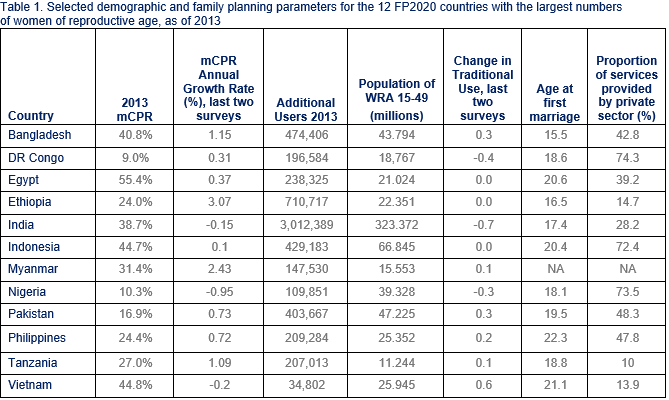A look at family planning dynamics among the ‘demographic giants’
One way to examine population and family planning dynamics is to examine case of FP2020 focus countries with the largest populations of women of reproductive age (WRA) – the so-called “demographic giants”. The table below presents selected demographic and family planning parameters for 12 such countries. The populations in these countries ranged from 11 million WRA in Tanzania to 323 million WRA in India.[1]

Demographic giants face unique pressures. Large populations require both substantial infrastructure to deliver services, but also must be flexible to meet the significant range of need and high density of need. They need programs capable of responding to existing levels of need, even while shaping demand and supply initiatives for populations not reached. While such countries have typically focused on delivering services in the aggregate, more recent initiatives have placed emphasis on using emerging evidence regarding the diversity of need and access within sub-populations. Initiatives under the National Health Rural Mission in India for example, have focused on addressing unmet need among postpartum women for example, with spacing and limiting methods, and new architecture to deliver services from community-based workers to public-private partnerships with maternal health institutions and private clinics. Similar strategies absorbing granular details of preferences are being tested and scaled up in Nigeria, Kenya and Senegal, focusing on the urban poor, in Indonesia addressing method mix in the context of universal health insurance, in Ethiopia expanding access to long-acting methods using community workers, among others.
The data on the demographic giants points to opportunities for family planning program improvement, and suggest that the circumstances for improvement vary widely among countries in this category. Hence, strategies for program enhancement must be developed on a country-by-country basis. With the exception of DRC, Nigeria, and Pakistan, mCPR is above 20% in all countries. The low is 9% in the DRC, and the high is 55% in Egypt. Two of the countries, Bangladesh and Tanzania, exhibit mCPR growth greater than 1% between the last two surveys, while Myanmar shows growth of 2.4%, and Ethiopia showed strong growth of over 3 percentage points. Four demographic giants experienced negative to negligible growth (India, Indonesia, Nigeria, and Viet Nam).
Just under one-half of the countries saw an increase in the use of traditional methods in the time period between the last two household surveys, which is a matter of some concern given the low effectiveness of traditional methods. Moderate to high private sector penetration is a feature of most of these markets, with the exceptions being Ethiopia, Tanzania, and Viet Nam. Overall age of first marriage is in early-to-late adolescence for the majority of these countries, increasing the length of exposure to pregnancies.
[1] All parameters are based on latest survey data for the selected countries except for Indicators 1a (mCPR) and 2 (additional modern method users), which are based on the annual estimates produced by FPET